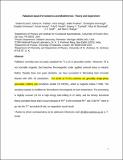Files in this item
Palladium-based ferroelectrics and multiferroics : theory and experiment
Item metadata
| dc.contributor.author | Kumari, Shalini | |
| dc.contributor.author | Pradhan, Dhiren K. | |
| dc.contributor.author | Ortega, Nora | |
| dc.contributor.author | Pradhan, Kallol | |
| dc.contributor.author | DeVreugd, Christopher | |
| dc.contributor.author | Srinivasan, Gopalan | |
| dc.contributor.author | Kumar, Ashok | |
| dc.contributor.author | Paudel, Tula R. | |
| dc.contributor.author | Tsymbal, Evgeny Y. | |
| dc.contributor.author | Bumstead, Alice | |
| dc.contributor.author | Scott, James Floyd | |
| dc.contributor.author | Katiyar, Ram S. | |
| dc.date.accessioned | 2017-07-03T16:30:12Z | |
| dc.date.available | 2017-07-03T16:30:12Z | |
| dc.date.issued | 2017-06-14 | |
| dc.identifier | 250088827 | |
| dc.identifier | 73d18cf0-d85d-4b45-952a-b916ffd9eb0e | |
| dc.identifier | 85023762493 | |
| dc.identifier | 000403225000001 | |
| dc.identifier.citation | Kumari , S , Pradhan , D K , Ortega , N , Pradhan , K , DeVreugd , C , Srinivasan , G , Kumar , A , Paudel , T R , Tsymbal , E Y , Bumstead , A , Scott , J F & Katiyar , R S 2017 , ' Palladium-based ferroelectrics and multiferroics : theory and experiment ' , Physical Review. B, Condensed matter and materials physics , vol. 95 , no. 21 , 214109 . https://doi.org/10.1103/PhysRevB.95.214109 | en |
| dc.identifier.issn | 1098-0121 | |
| dc.identifier.uri | https://hdl.handle.net/10023/11137 | |
| dc.description.abstract | Palladium normally does not easily substitute for Ti or Zr in perovskite oxides. Moreover, Pd is not normally magnetic (but becomes ferromagnetic under applied uniaxial stress or electric fields). Despite these two great obstacles, we have succeeded in fabricating lead zirconate titanate with 30% Pd substitution. For 20:80 Zr:Ti the ceramics are generally single-phase perovskite (>99%), but sometimes exhibit 1% PbPdO2, which is magnetic below T=90K. The resulting material is multiferroic (ferroelectric-ferromagnet) at room temperature. The processing is slightly unusual (>8 hrs in high-energy ball-milling in Zr balls), and the density functional theory provided shows that it occurs because of Pd+4 in the oversized Pb+2 site; if all Pd+4 were to go into the Ti+4 perovskite B-site, no magnetism would result. | |
| dc.format.extent | 9 | |
| dc.format.extent | 1888334 | |
| dc.language.iso | eng | |
| dc.relation.ispartof | Physical Review. B, Condensed matter and materials physics | en |
| dc.subject | QC Physics | en |
| dc.subject | QD Chemistry | en |
| dc.subject | T Technology | en |
| dc.subject | NDAS | en |
| dc.subject.lcc | QC | en |
| dc.subject.lcc | QD | en |
| dc.subject.lcc | T | en |
| dc.title | Palladium-based ferroelectrics and multiferroics : theory and experiment | en |
| dc.type | Journal article | en |
| dc.contributor.institution | University of St Andrews. School of Chemistry | en |
| dc.contributor.institution | University of St Andrews. School of Physics and Astronomy | en |
| dc.contributor.institution | University of St Andrews. Condensed Matter Physics | en |
| dc.identifier.doi | https://doi.org/10.1103/PhysRevB.95.214109 | |
| dc.description.status | Peer reviewed | en |
This item appears in the following Collection(s)
Items in the St Andrews Research Repository are protected by copyright, with all rights reserved, unless otherwise indicated.

